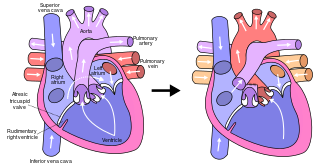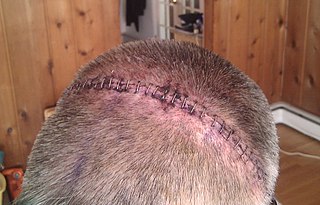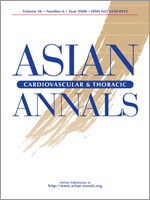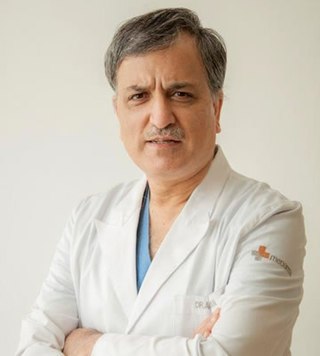
Pectus excavatum is a structural deformity of the anterior thoracic wall in which the sternum and rib cage are shaped abnormally. This produces a caved-in or sunken appearance of the chest. It can either be present at birth or develop after puberty.

The Fontan procedure or Fontan–Kreutzer procedure is a palliative surgical procedure used in children with univentricular hearts. It involves diverting the venous blood from the inferior vena cava (IVC) and superior vena cava (SVC) to the pulmonary arteries without passing through the morphologic right ventricle; i.e., the systemic and pulmonary circulations are placed in series with the functional single ventricle. The procedure was initially performed in 1968 by Francis Fontan and Eugene Baudet from Bordeaux, France, published in 1971, simultaneously described in 1971 by Guillermo Kreutzer from Buenos Aires, Argentina, and finally published in 1973.

The Norwood procedure is the first of three surgeries intended to create a new functional systemic circuit in patients with hypoplastic left heart syndrome and other complex heart defects with single ventricle physiology. The first successful Norwood procedure involving the use of a cardiopulmonary bypass was reported by Dr. William Imon Norwood, Jr. and colleagues in 1981.
Mitral valve replacement is a procedure whereby the diseased mitral valve of a patient's heart is replaced by either a mechanical or tissue (bioprosthetic) valve.

Surgical staples are specialized staples used in surgery in place of sutures to close skin wounds or connect or remove parts of the bowels or lungs. The use of staples over sutures reduces the local inflammatory response, width of the wound, and time it takes to close.
David H. Adams is an American cardiac surgeon and the Marie-Josée and Henry R. Kravis Professor and Chairman of the Department of Cardiothoracic Surgery, Icahn School of Medicine at Mount Sinai Hospital in New York City. Dr. Adams is a recognized leader in the field of heart valve surgery and mitral valve reconstruction. As director of Mount Sinai Mitral Valve Repair Center, he has set national benchmarks with >99% degenerative mitral valve repair rates, while running one of the largest valve repair programs in the United States. Dr. Adams is the co-inventor of 2 mitral valve annuloplasty repair rings – the Carpentier-McCarthy-Adams IMR ETlogix Ring and the Carpentier-Edwards Physio II Annuloplasty Ring, and is a senior consultant with royalty agreements with Edwards Lifesciences. He is also the inventor of the Tri-Ad Adams Tricuspid Annuloplasty ring with a royalty agreement with Medtronic. He is a co-author with Professor Alain Carpentier of the benchmark textbook in mitral valve surgery Carpentier's Reconstructive Valve Surgery. He is also the National Co-Principal Investigator of the FDA pivotal trial of the Medtronic-CoreValve transcatheter aortic valve replacement device.
Endoscopic vessel harvesting (EVH) is a surgical technique that may be used in conjunction with coronary artery bypass surgery. For patients with coronary artery disease, a physician may recommend a bypass to reroute blood around blocked arteries to restore and improve blood flow and oxygen to the heart. To create the bypass graft, a surgeon will remove or "harvest" healthy blood vessels from another part of the body, often from the patient's leg or arm. This vessel becomes a graft, with one end attaching to a blood source above and the other end below the blocked area, creating a "conduit" channel or new blood flow connection across the heart.
Lars Georg Svensson is a cardiac surgeon and the chairman of the heart and vascular institute at Cleveland Clinic. He is the Director of the Aorta Center, Director of the Marfan Syndrome and Connective Tissue Disorder Clinic, and is a professor of surgery at Cleveland Clinic Lerner College of Medicine and Case Western Reserve University. He is also the Director of Quality Outcomes and Process Improvement for the Department of Thoracic and Cardiovascular Surgery and Affiliate Cardiac Surgery Program at Cleveland Clinic.
Pulmonary Artery Banding (PAB) was introduced by Muller and Dammann in 1951 as a surgical technique to reduce excessive pulmonary blood flow in infants suffering from congenital heart defects. PAB is a palliative operation as it does not correct the problems, but attempts to improve abnormal heart function, relieve symptoms and reduce high pressure in the lungs. The use of PAB has decreased over the years due to advancements in definitive surgical repairs, however PAB still has widespread clinical use. PAB is commonly used in patients when definitive surgical repair is not feasible.
Dasari Prasada Rao is an Indian Cardiothoracic surgeon. He was noteworthy for introducing the first open heart surgery to the state of Andhra Pradesh in India and for pioneering advanced medical care at affordable costs. Dasari Prasada Rao has won numerous awards including in 2001 the Padma Shri award, a Civilian award bestowed by the Government of India.

Asian Cardiovascular and Thoracic Annals is a bimonthly peer-reviewed academic journal that covers research in the fields of cardiology and cardiovascular medicine. The editor-in-chief is Yutaka Okita. It was established in 1993 by founder, Frank Tamru who launched Asia Publishing Exchange in Singapore to publish the region’s first scientific journal for cardiovascular and thoracic surgeons. The journal was preceded by APEX circulated by Tamru from 1985 to 1992 throughout Asia to inform readers of new developments in heart surgery, meeting dates & venues, and profiles on the region’s leading cardiac surgeons. The journal is currently published by SAGE Publications in association with the Asian Society for Cardiovascular and Thoracic Surgery.

Félicien M. Steichen was a Luxembourgish-born American surgeon and Professor of Surgery. He was a pioneer in the development and use of surgical staples. He and Mark M. Ravitch are considered the fathers of modern surgical stapling. Steichen was also noted for his contributions to the development of minimally-invasive surgery.
Floyd John Lewis was an American surgeon who performed the first successful open heart operation, closing an atrial septal defect in a 5-year-old girl, on 2 September 1952. For the next 3 years, Lewis and colleagues operated on 60 patients with atrial septal defects using hypothermia and inflow occlusion. He was best friends with C. Walton Lillehei and they worked together at the University of Minnesota.

Nina Starr Braunwald (1928–1992) was an American thoracic surgeon and medical researcher who was among the first women to perform open-heart surgery. She was also the first woman to be certified by the American Board of Thoracic Surgery, and the first to be elected to the American Association for Thoracic Surgery. In 1960, at the age of 32, she led the operative team at the U.S. National Institutes of Health (NIH) that implanted the first successful artificial mitral human heart valve replacement, which she had designed and fabricated. She died in August 1992 in Weston, Massachusetts, after a career that included prominent appointments at the NIH, University of California, San Diego, Harvard Medical School, and Brigham and Women's Hospital.
AME Publishing Company is an academic publishing company, which publishes medical journals and books. Founded in July 2009, it is currently headquartered in Hong Kong, with additional offices in Guangzhou, Changsha, Nanjing, Shanghai, Chengdu, Beijing, Taipei, and Hangzhou. Its name stands for "Academic Made Easy/Excellent/Enthusiastic". It has published over 50 medical journals, as well as 20 English-language books, 28 Chinese-language books, and 60 e-books.

In cardiac surgery and vascular surgery, external support is a type of scaffold made of metal or plastic material that is inserted over the outside of the vein graft in order to decrease the intermediate and late vein graft failure after bypass surgery.

Dr. Anil Bhan is the Chairman of Cardiac Surgery Heart Institute, Medanta Hospital, Gurugram, India. He graduated from Medical College Srinagar. He has the largest experience in aortic surgery in India since he has designed and developed more than 50 surgical instruments in the field of cardiac surgery. He was one of the team members to perform the first successful heart transplant in India in1994. He served as a co-founder of Max Heart and Vascular Institute, Saket, New Delhi, Director and Chief Co-Ordinator, Cardio thoracic and Vascular Surgery, MHVI, Saket.Additional Professor, Cardiothoracic Surgery and Vascular Surgery, AIIMS, New Delhi.

George E. Green is an American cardiac surgeon best known for pioneering and implementing the first surgical procedure of the left coronary artery bypass graft using the internal thoracic artery sutured to the left anterior descending coronary artery to bypass obstruction to the heart circulation in the late 1960s. He applied these techniques in 1968 at New York University Medical Center and in 1970 he was hired to establish St. Luke's Hospital's cardiac surgery program in Manhattan, New York, that by 1982 was seeing approximately 1,800 cases a year, the biggest program in the state. Green has lectured internationally on the topic and has written numerous reports on internal thoracic artery grafting as well as co-authoring, Surgical Revascularization of the Heart: The Internal Thoracic Arteries.
Genevieve Hidden was French surgeon who specialised in lymphology. She was one of the first to demonstrate the safe transplantation of lymph nodes. She was a founding member of the European Society of Lymphology.









